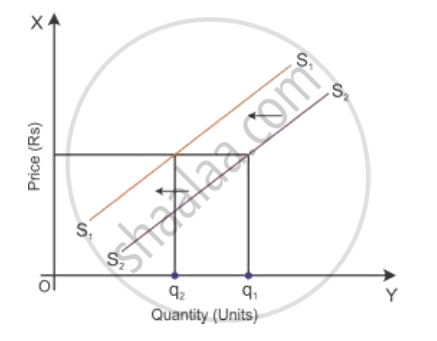Advertisements
Advertisements
Question
What is 'change in supply'? Explain the effect of tax imposed on a good on the supply of the good.
Solution
Change in supply means a situation where there will be an increase or decrease in the quantity of a good supplied at a constant price. At a constant price, changes in other factors of production will cause a change in supply. The change will cause a forward or backward shift in the curve as (i) an increase in supply and (ii) a decrease in supply.
Assuming other things remain constant, the levy of a tax on a good shows a negative relationship with the supply of a good. When there is a tax on a good, the cost of production increases and decreases the profit of the producer. Hence, it leads to a decrease in the supply of a good which shifts the supply curve towards the left, i.e. S2S2 to S1S1.

APPEARS IN
RELATED QUESTIONS
Explain the difference between “Shift of Supply Curve” and “Movement along Supply Curve”. State one factor responsible for each. Use diagrams.
When does 'shift' in supply curve take place?
Which of the following does not cause shift of supply curve of a good?
(Choose the correct alternative)
(a) Price of input
(b) Price of the good
(c) Goods and services tax
(d) Subsidy
Fill in the blank.
If the market supply of a commodity X changes due to improvement in technology, the market supply curve will ___________.
Fill in the blank.
If the market supply of a commodity X changes due to a rise in the price of factor input, the market supply curve will ____________.
Choose the correct answer from given options
If the supply curve is a straight line parallel to the vertical axis (Y-axis), supply of the good is called as _________.
Which one of the following will cause a rise in the equilibrium price of rice when the demand for rice remains the same?
An increase in the number of firms in the market causes a rightward shift in the market supply curve, but the individual supply curve may shift leftward. Justify the statement.
